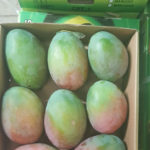 Despite the growth of the mango sector in Kenya, there are still gaps for value addition such as the making of juices and puree. The government has established several processing plants in the Coast and other regions while key exporters have their private processors. Despite these developments, there are still many surplus mangos that do not make it to the market and unless they are processed, they easily turn into losses. One new development to alleviate the problem is homemade processing means by farmers who have discovered a humble means of adding value to their fruits that either do not make it to the market or are in excess. For instance in Kambiti Zone of Murang’a in Central Kenya, crisps made from mangos are the latest snacks in town.
Despite the growth of the mango sector in Kenya, there are still gaps for value addition such as the making of juices and puree. The government has established several processing plants in the Coast and other regions while key exporters have their private processors. Despite these developments, there are still many surplus mangos that do not make it to the market and unless they are processed, they easily turn into losses. One new development to alleviate the problem is homemade processing means by farmers who have discovered a humble means of adding value to their fruits that either do not make it to the market or are in excess. For instance in Kambiti Zone of Murang’a in Central Kenya, crisps made from mangos are the latest snacks in town.
The family growers usually harvest, dry and then grind the mangoes. This keeps them usable even when they only have a few days to lose freshness. They then make crisps that customers can use in the same manner as they do cakes. The processing entails heating the cut out pieces of the fruit which turns them into consumer snacks. The farmers also grind the fruits into flour-like mango powder that can feature in spicing meals.
This Kenya mango value addition takes place through three main stages. The first one is the delivery of the harvest to the processing area that the farmer groups operate. They then weigh them to allocate payments before chopping follows. After this they insert the sliced pieces into dryers. Finally, they use food safety labels sachets to pack the crisps that are by then dry. They also retail the powder in separate packets.
Mango Retail
Kenya mangos are mostly consumed locally. For instance in 2010, just 0.4 percent of the fruit underwent export processing. In that year, mangos also constituted 26 percent of all fruit exports after avocados at 62 percent. This means that were more efforts given to processing them, they would enjoy a higher export to home consumption ratio than thy currently have.
The smallest mangos cost on average $0.01 to $0.02 at the town market while the larger sizes like Tommy Atkins can fetch up to $0.3. These values usually change by season and also fluctuate depending on demand factors. The export price is also dependent on the international prices, which means that farmers earn profit when there is an export window when other producers have no mangos.
Mango Growth
In Kenya, mangoes thrive in relatively warm climatic regions at temperatures of 20 to 26° Celsius. They are best to grow in low to mid-altitude regions. This is why the low-lying Eastern and Coastal belts provide for the best places to cultivate them. Their rainfall needs are equally low at between 500 and 1000 millimeters annually, which makes them viable for the semi-arid regions of the country.
The main botanic categories of Kenya mangos are polyembryonic and monoembroyinc. The former include traditional cultivars like ngowe and Boribo mangos that have grown for centuries in the Coast. These usually sprout from seeds rather than grafted copies. Unlike the polyembryinic types, monoembryonic are either grafted or improved from other varieties. They include Keitt, Tommy atkins and Kent, among others. These can grow through cuttings and seedlings which are available in the market.
Therefore, as mango is a staple of the country’s relatively hot regions, farmers may find it very welcoming to make extra income. This way the fruits do not go into waste especially due to poor storage. There are also many upcoming value addition plants such as the one in Hola in the Tana River County of the Coast that have enabled locals to enhance their mango processing needs.

